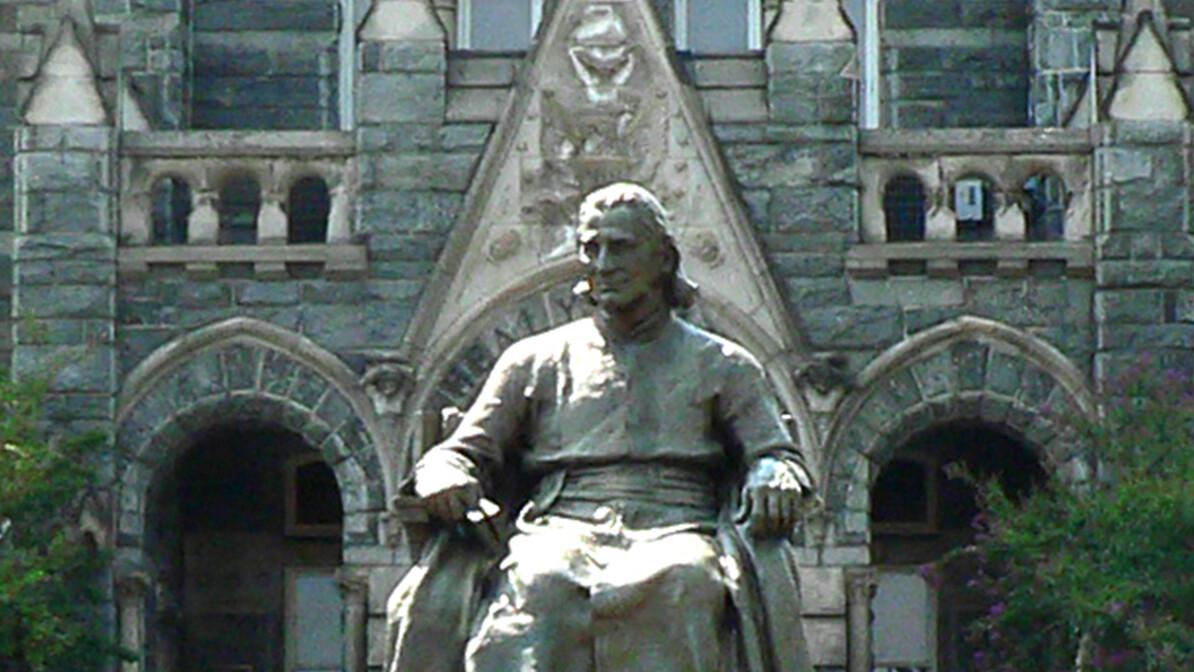
Healthcare & Hospitals Pioneered by Christian Charity (Part 3)
At the time of the Revolutionary War, the United States had a population of 3 million, which was:
- 98 percent Protestant,
- 1 percent Catholic,
- 1/10th of 1 percent Jewish.
After the Great Irish Potato Famine, 1845- 1849, immigration raised the Catholic population in America to over 20 percent. In modern America, the Catholic Church has the largest membership and is the nation’s largest medical care provider with over 600 hospitals and 500 long-term health care facilities.
As of 2018, 10 of the 25 largest health-care networks in the U.S. are Catholic affiliated, including:
- Catholic Health Initiatives – 78 hospitals
- Ascension Health – 67 hospitals – Daughters of Charity, Congregation of St. Joseph, Sisters of St. Joseph
- Trinity Health – 44 hospitals, 379 Clinics, Catholic Health Ministries
- Catholic Healthcare West – 41 hospitals, Sisters of Mercy
- Catholic Health East – 34 hospitals, 9 religious congregations & Hope Ministries
- Catholic Healthcare Partners – 33 hospitals, Sisters of Mercy, Daughters of Charity
- Providence Health & Services – 26 hospitals, Sisters of Providence, Sisters of the Little Company of Mary
- Marian Health System – 25 hospitals, Sisters of the Sorrowful Mother
The Case Against the HHS Healthcare Mandates
On May 21, 2012, the Archdiocese of New York filed a historic Federal lawsuit against the HHS mandate:
“In order to protect our religious liberties from unwarranted and unprecedented government intrusion, the Archdiocese of New York has filed suit in federal court today seeking to block the recent Health and Human Services mandate that unconstitutionally attempts to define the nature of the Church’s religious ministry and would force religious employers to violate their consciences.”
Cardinal Timothy Dolan, Archbishop of New York, October 29, 2012, responded to President Obama’s HHS healthcare mandates. “It is not just about sterilization, abortifacients, and chemical contraception … It’s about religious freedom, the sacred right, protected by our constitution …”
Cardinal Dolan, as President of the United States Conference of Catholic Bishops (USCCB), 2010-2013, continued:
“President Obama announced … the choking mandates from HHS would remain – a shock to me, since he had personally assured me that he would do nothing to impede the good work of the Church … that he considered the protection of conscience a sacred duty .. There was still no resolution about the handcuffs placed upon … Catholic charitable agencies … just because they will not refer victims of human trafficking, immigrants and refugees, and the hungry of the world, for abortions, sterilization, or contraception.”
The United States Conference of Catholic Bishops stated October 12, 2012, regarding a supposed “exemption” to the HHS mandate:
“Last night, the … statement was made during the Vice Presidential debate regarding the decision of the U.S. Department of Health and Human Services (HHS) to force virtually all employers to include sterilization and contraception, including drugs that may cause abortion, in the health insurance coverage they provide their employees … That exemption … does not extend to ‘Catholic social services, Georgetown Hospital’ … or any other religious charity.”
Georgetown Hospital was founded in 1898 as part of Georgetown University. Georgetown University was founded January 23, 1789, by John Carroll, America’s first Catholic Bishop.
The Influence of Bishop John Carroll on Healthcare
Regarding freedom of conscience, Bishop John Carroll sent a report to Rome in 1790:
“In 1776, American Independence was declared, and a revolution effected, not only in political affairs, but also in those relating to Religion. For while the thirteen provinces of North America rejected the yoke of England, they proclaimed, at the same time, freedom of conscience, and the right of worshiping the Almighty, according to the spirit of the religion to which each one should belong …”
Bishop Carroll continued:
“Before this great event, the Catholic faith had penetrated two provinces only, Maryland and Pennsylvania. In all the others, the laws against Catholics were in force. Any priest coming from foreign parts was subject to the penalty of death; all who professed the Catholic faith were not merely excluded from offices of government, but hardly could be tolerated in a private capacity … By the Declaration of Independence, every difficulty was removed: the Catholics were placed on a level with their fellow Christians, and every political disqualification was done away.”
Regarding religious freedom, Bishop John Carroll wrote in the National Gazette, 1789:
“The establishment of the American empire was not the work of this or that religion, but arose from a generous exertion of all her citizens to redress their wrongs, to assert their rights, and lay its foundations on the soundest principles of justice and equal liberty … An earnest regard to preserve inviolate forever, in our new empire, the great principle of religious freedom.”
John Carroll was the cousin of Charles Carroll, the only Catholic to sign the Declaration of Independence, the longest living of the signers, and the wealthiest man in America. John’s brother, Daniel Carroll, was one of two Catholics to sign the U.S. Constitution, who provided the land where the Capitol is built and was elected a Congressman. John’s nephew, Robert Brent was the first mayor of Washington, D.C., being reappointed by Jefferson and Madison.
John Carroll founded the nation’s first Catholic seminary, parochial school system, and persuaded Elizabeth Seton to start a girls school in Baltimore.
In 1776, the Continental Congress had John Carroll accompany Ben Franklin to Canada in an attempt to persuade that country to join the revolution.
High esteem for Bishop John Carroll led several states to extend equality to Catholics. Bishop Carroll wrote of Catholics who fought in the revolution:
“Their blood flowed as freely (in proportion to their numbers) to cement the fabric of independence as that of any of their fellow-citizens. They concurred with perhaps greater unanimity than any other body of men, in recommending and promoting that government, from whose influence America anticipates all the blessings of justice, peace, plenty, good order and civil and religious liberty.”
Bishop Carroll wrote:
“Freedom and independence, acquired by … the mingled blood of Protestant and Catholic fellow-citizens, should be equally enjoyed by all.”
Assuring protection for freedom of conscience, President George Washington wrote to Bishop John Carroll, March 15, 1790:
“America, under the smiles of a Divine Providence, the protection of a good government, and the cultivation of manners, morals, and piety, cannot fail of attaining an uncommon degree of eminence … All those who conduct themselves as worthy members of the community are equally entitled to the protection of civil government. I hope ever to see America among the foremost nations in examples of justice and liberality …”
Washington continued:
“And I presume that your fellow-citizens will not forget the patriotic part which you took in the accomplishment of their Revolution, and the establishment of their government; or the important assistance which they received from a nation in which the Roman Catholic faith is professed.”
Charles Carroll paid for the building of a large house for his son, which was later donated to be the main campus of Johns Hopkins University, with its world-renown Schools of Nursing and Medicine. Dr. Ben Carson, U.S. Secretary of Housing and Urban Development, was Director of Pediatric Neurosurgery at Johns Hopkins Hospital from 1984 until his retirement in 2013.
George Washington ended his letter to Bishop John Carroll:
“May the members of your society in America, animated alone by the pure spirit of Christianity, and still conducting themselves as the faithful subjects of our free government, enjoy every temporal and spiritual felicity.”
…
Featured image credit: Patrickneil / John Carroll Statue / CC BY-SA 3.0
1st interior image credit: Cy White / Archbishop Timothy Dolan / CC BY 2.0
2nd interior image credit: U.S. Library of Congress’s Prints and Photographs / University Hospital Georgetown / Public Domain
3rd interior image credit: Daderot / George Washington by Rembrandt Peale / CCO 1.0
Trending Now
Sign up today for your Inspiration Today Daily Newsletter
Supercharge your faith and ignite your spirit. Find hope in God’s word. Receive your Inspiration Today newsletter now!
William Federer
William Federer is a nationally known speaker, best-selling author, and president of Amerisearch, Inc., a publishing company dedicated to researching America's noble heritage. Bill's American Minute radio feature and his Faith in History television broadcast can be viewed daily across America and on the Internet. Learn more at amerisearch.net
Related Articles
November 21, 2025
Thank You … Lord
Gratitude transforms our lives and draws us closer to God. This article explores how practicing…
October 27, 2025
So, Is God Good?
Many people wrestle with the question, is God good, especially when life brings pain and loss.…
September 30, 2025
God Wants to Heal You!
This article is a powerful reminder that God doesn't just want to forgive your sins. He longs to…
September 27, 2025
When You Need God’s Healing Touch
When you need God’s healing touch, the Bible assures us that He is both willing and able to restore…
Next Steps To Strengthen Your Walk
Inspiration Today Newsletter
Supercharge your faith and ignite your spirit. Find hope in God’s word. Receive your Inspiration Today newsletter now!
Christian Articles
Find articles to strengthen your walk and grow your faith. We have a wide range of topics and authors for you.
Submit A Prayer Request
We are here for you. Simply click on the button below to reach us by form, email or phone. Together we will lift our hearts and voices with you in prayer.





